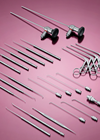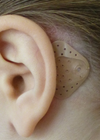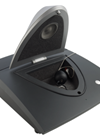Spotlight on Innovation
Development of a new negative-pressure ventilatory support device: Exovent
The pandemic has driven innovation in ways that we have not seen for many decades. Intensive care medicine and ENT have been at the forefront of these advances, and our good friends David Howard (never one to put his feet...
Portable otoscopy image capture devices – a comparative review
The use of photo documentation in ENT clinics is becoming more common as technological advances have made the hardware required more accessible. There is significant variation in the price of products. Daniel Moualed, Olivia Whiteside and Chris Aldren review the...
PHACON artificial bone models for ENT training
Simulation, both in training and clinical practice, has become an increasingly important facet of a surgeon’s life. The escalating costs of cadaveric material makes synthetic alternatives an attractive proposition but, up until recently, these artificial versions have lacked the material...
The hearScope
A revolutionary new otoscope is using artificial intelligence to dramatically improve access to ear and hearing care in South African outreach communities. Carolina Leal, spoke to Professor De Wet Swanepoel of the University of Pretoria about how his team developed...
Panetti Endoscopic Ear Instruments
Giuseppe Panetti is a renowned otologist and one of the forerunners of endoscopic ear surgery. One of his major contributions to ENT has been through designing bespoke equipment to assist in some of the challenges of operating endoscopically. In this...
KARL STORZ Endoscopic Ear Surgery Set
Marcus Brechtold, Senior Director of Product Management – Oto-Rhino-Laryngology, OMFS, Spine and Neurosurgery at KARL STORZ GMBH & Co. KG, tells EES Guest Editor, Chris Coulson, about the company’s new Endoscopic Ear Surgery Set, developed in collaboration with the International...
Adjoin™ bone conduction system
Patrik Westerkull (PW), Otorix AB, and Ann-Louise McDermott (A-LM), ENT Consultant at Birmingham Children’s Hospital, tell us about the Adjoin bone conduction device, a non-surgical bone-conduction option developed by Otorix. They explain how the product works, the background to the...
New bone anchored hearing implant reaches clinical milestone
A new implant for bone-conduction hearing, BCI (Bone Conduction Implant), has been developed by Bo Håkansson and his team of researchers at Chalmers University of Technology and Sahlgrenska University Hospital, both in Gothenburg, Sweden. Unlike most bone-conduction devices used today,...
VES2 is ready to bring ear surgery into your living room
The VES2 virtual reality bone drilling simulator is ready and it is freeware! After a long development period we are now able to invite everybody to try the simulator and use it for training, for a inner ear anatomy, and...
How to tell if a bone anchored hearing device is working?
Bone anchored hearing aids are becoming increasingly more commonplace with more than 120,000 users worldwide. These devices are based on the principle of direct bone conduction, where sound is transmitted directly through the skull via a titanium implant to the...














